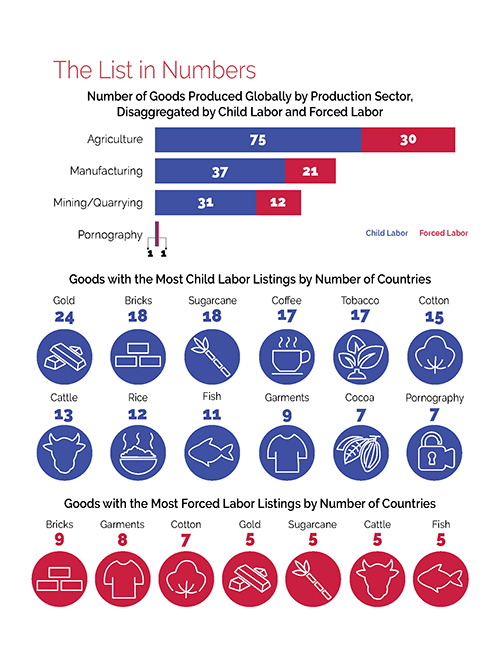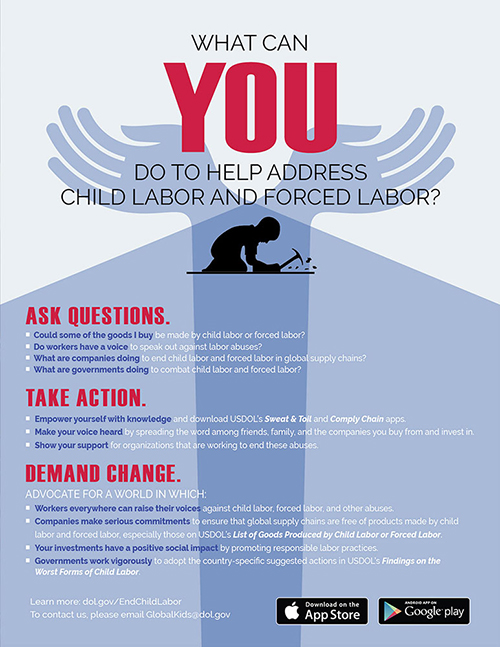List of Goods Produced by Child Labor or Forced Labor
The Bureau of International Labor Affairs (ILAB) maintains a list of goods and their source countries which it has reason to believe are produced by child labor or forced labor in violation of international standards, as required under the Trafficking Victims Protection Reauthorization Act (TVPRA) of 2005 and subsequent reauthorizations. The List of Goods Produced by Child Labor or Forced Labor comprises 159 goods from 78 countries and areas, as of September 28, 2022.
ILAB maintains the List primarily to raise public awareness about forced labor and child labor around the world and to promote efforts to combat them; it is not intended to be punitive, but rather to serve as a catalyst for more strategic and focused coordination and collaboration among those working to address these problems.
Publication of the List has resulted in new opportunities for ILAB to engage with foreign governments to combat forced labor and child labor. It is also a valuable resource for researchers, advocacy organizations and companies wishing to carry out risk assessments and engage in due diligence on labor rights in their supply chains.
The countries on the List span every region of the world. The most common agricultural goods listed are sugarcane, cotton, coffee, tobacco, cattle, rice, and fish. In the manufacturing sector, bricks, garments, textiles, footwear, carpets, and fireworks appear most frequently. In mined or quarried goods, gold, coal and diamonds are most common.
ILAB published the initial TVPRA List in 2009 and updated it annually through 2014, following a set of procedural guidelines that were the product of an intensive public consultation process. ILAB now updates and publishes the List every other year, pursuant to changes in the law.
Procedural Guidelines
On January 25, 2024, ILAB's Office of Child Labor, Forced Labor, and Human Trafficking published Procedural Guidelines for the development and maintenance of the List of Goods from countries produced by child labor or forced labor in violation of international standards.
| Country/Area | Good | Exploitation Type |
|---|---|---|
| Brazil | Child Labor | |
| Burma | There are reports that children as young as age nine are forced to work in the production of rice in Burma. According to NGOs, villagers, including children, are forced to work planting and harvesting rice for the military camps. These children are forced to work on rotation year-round for the military, although most rice paddy cultivation occurs during the rainy season. Local officials and the military enforce the work orders, and workers cannot refuse to work, even if sick. The forced child laborers are not paid for their work, and the children are beaten if their work is considered to be of unacceptable quality. |
Child Labor, Forced Labor |
| Dominican Republic | Child Labor | |
| Ecuador | There are reports that children ages 5 to 17 work in the production of rice in Ecuador. Based on the analysis of Ecuador’s 2019 National Survey of Employment, Unemployment, and Underemployment, an estimated 5,896 children under the minimum age for work are involved in child labor in rice production. The ILO has found that generally, children who work in agriculture may be at risk of exposure to hazards including working long hours, carrying heavy loads, using dangerous tools, exposure to the elements, physical injuries, and chemicals, such as pesticides. The release of this survey demonstrates the Government of Ecuador’s commitment to addressing child labor and its acknowledgement that data collection is vital to the design and implementation of sound policies and programs. |
Child Labor |
| Ghana | There is evidence that children ages 5 to 14 are involved in the growing of rice in Ghana. Based on an analysis of the Ghana Living Standards Survey, an estimated 19,124 child laborers are involved in the growing of rice. There are some health and safety issues associated with the growing of rice that include extended time out in the sun, burns from the parboiling process, and infections from harvesting in the rice paddies. The release of this survey demonstrates the Government of Ghana’s commitment to addressing child labor and its acknowledgement that data collection is vital to the design and implementation of sound policies and programs. |
Child Labor |
| India | There are reports of children working under conditions of forced labor in rice mills in India, particularly in Tamil Nadu. These children are forced to work producing rice through a system of bonded labor, often working with their families. Children of the lower castes, socially disadvantaged classes in India, are particularly vulnerable. According to an ILO study, over 1,000 families work in bonded labor in rice mills in one district of Tamil Nadu. Families take an advance payment from recruiters and then are forced to work to pay off the debt. Some children face harassment and restrictions on their movement from mill personnel. |
Child Labor, Forced Labor |
| Kenya | Child Labor | |
| Mali | There are reports that children are forced to work cultivating rice in Mali, particularly along the Niger River and in the Segou region. According to a university study and the ILO, some children are trafficked in groups of 25 to 50, and an estimated 2,000 children have been forced to work in rice fields in Mali. Some children are known to be recruited from villages in other parts of Mali to cultivate rice in Niono. Boys are also trafficked from Burkina Faso to produce rice in Mali. Some boys ages 10-15 from Burkina Faso and Mali are sent to work in rice fields by their Koranic teachers at religious schools. Organized trafficking rings link the farmers with the teachers and the children. These boys receive no pay for their work; the farmers pay the teachers and the recruiters for the boys' labor. |
Child Labor, Forced Labor |
| Pakistan | There is evidence that children under the age of 14 cultivate rice in Pakistan. An analysis of the Pakistan Labour Force Survey 2017–2018 considers all work performed by children under age 14 to be child labor. Based on an analysis of the survey, it is estimated that 31,628 child laborers cultivate rice. The ILO has found that generally, children who work in agriculture may be at risk of exposure to hazards including working long hours, carrying heavy loads, using dangerous tools, and exposure to the elements, physical injuries, and chemicals. Children working in the rice fields face exposure to fertilizers, insecticides, and pesticides. Long hours in the sun with minimal protection can result in persistent health concerns including eye infections, skin irritation and diseases, and respiratory illnesses. The release of this survey demonstrates the Government of Pakistan’s commitment to addressing child labor and its acknowledgment that data collection is vital to the design and implementation of sound policies and programs. |
Child Labor |
| Philippines | Child Labor |
your hand? Download ILAB's Sweat & Toil App today!
Are you a company looking to fight child labor and forced labor in supply
chains?





